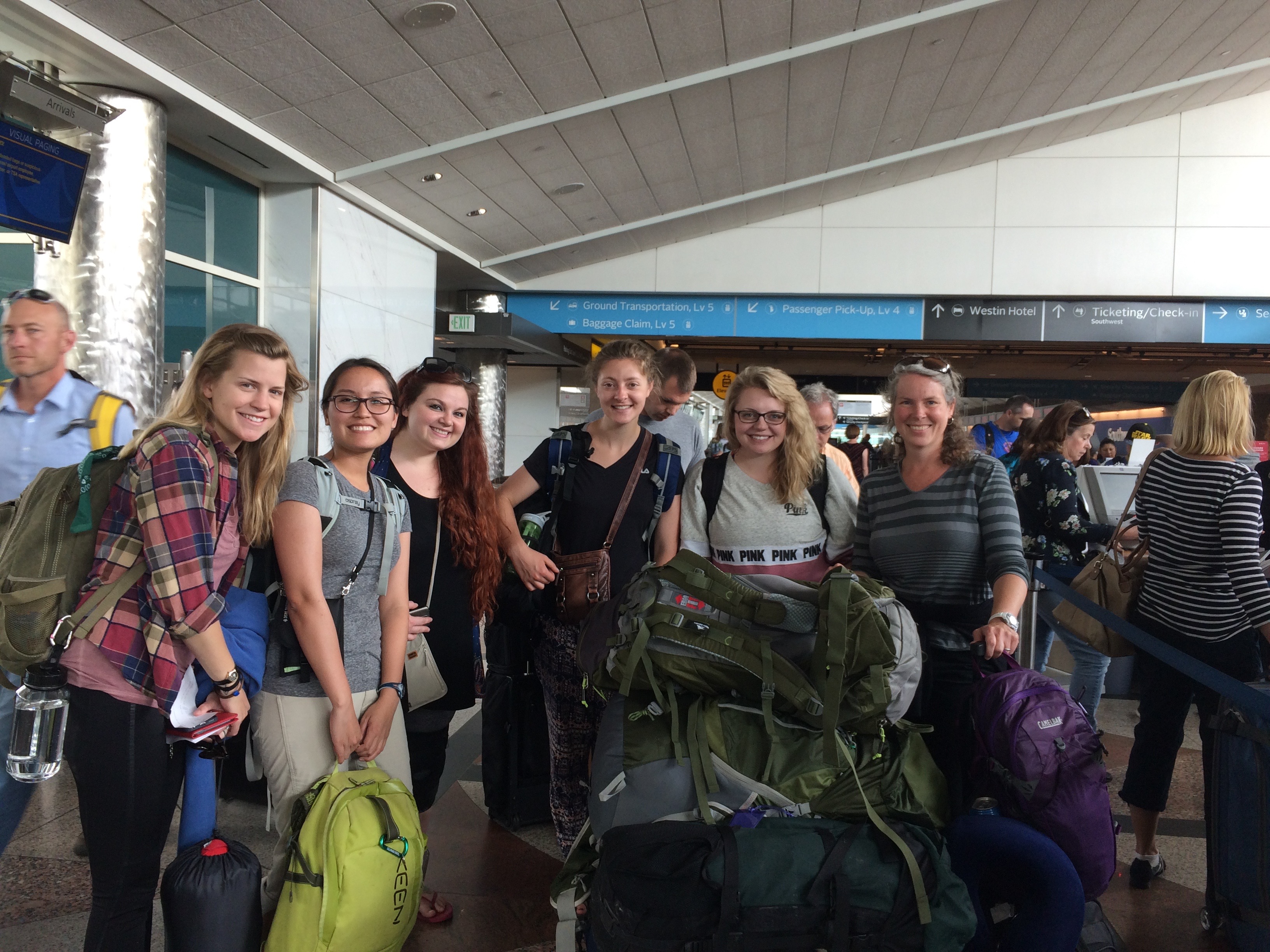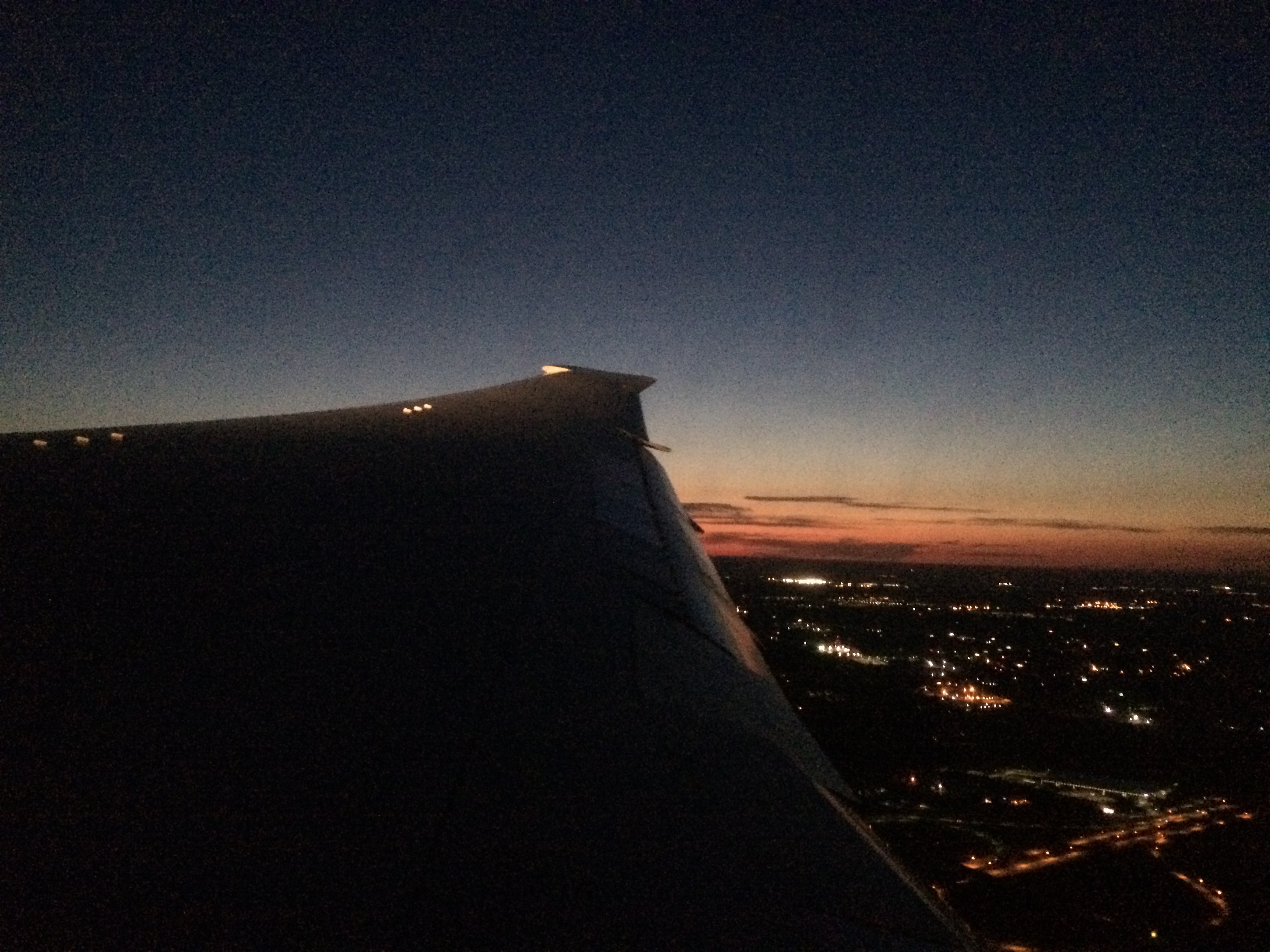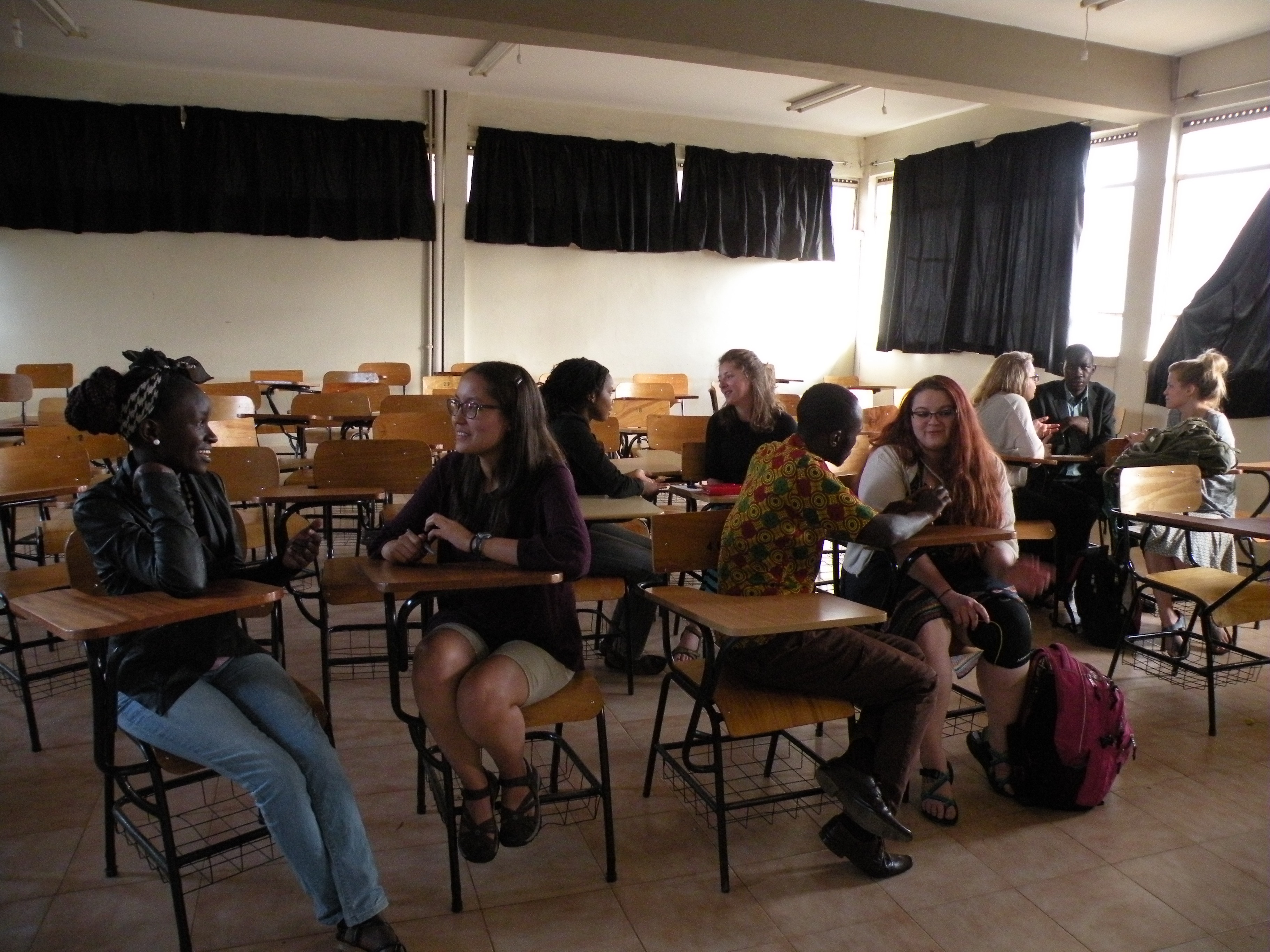
East Africa IRES #2: New Friends and Colleagues
EA-IRES #2
 The 2016 EA-IRES crew from Colorado State University arrived in Nairobi, Kenya on Tuesday, June 7th. Our travels went smoothly through Detroit, Amsterdam (the boarding line!), and on to Nairobi. And only one bag did not arrive out of our 8 checked bags… We finally arrived at our hotel at 1:30am after some 31 hours on the road, and everyone headed straight to sleep. Today we slept in just a bit, and then spent most of the day at University of Nairobi’s Upper Kabete Campus where the College of Agriculture and Veterinary Sciences (CAVS) is located. Our partners on this project work with the African Drylands Institute for Sustainability (ADIS), which is housed within CAVS (Professor Jesse Njoka is the Director of ADIS). We met the of Land Resource Management and Agricultural Technology (LARMAT) Chairman, Professor Geoffrey Kironchi, and others in the college, giving our EA-IRES Fellows the opportunity to interact with and get to know both faculty members and students. It was hard to tear them away… see more below on our student perspectives of these meetings.
The 2016 EA-IRES crew from Colorado State University arrived in Nairobi, Kenya on Tuesday, June 7th. Our travels went smoothly through Detroit, Amsterdam (the boarding line!), and on to Nairobi. And only one bag did not arrive out of our 8 checked bags… We finally arrived at our hotel at 1:30am after some 31 hours on the road, and everyone headed straight to sleep. Today we slept in just a bit, and then spent most of the day at University of Nairobi’s Upper Kabete Campus where the College of Agriculture and Veterinary Sciences (CAVS) is located. Our partners on this project work with the African Drylands Institute for Sustainability (ADIS), which is housed within CAVS (Professor Jesse Njoka is the Director of ADIS). We met the of Land Resource Management and Agricultural Technology (LARMAT) Chairman, Professor Geoffrey Kironchi, and others in the college, giving our EA-IRES Fellows the opportunity to interact with and get to know both faculty members and students. It was hard to tear them away… see more below on our student perspectives of these meetings.
 We also met with all of the University of Nairobi representatives who will be joining us in Samburu to serve as mentors for the students. PhD student Henry Kahi, Rangeland Science lecturer in LARMAT, and two female students in Rangeland Science and in Soil Science, Jacline and Bernice (you will hear more about and from them in the coming days!), will be joining us on our research and learning adventure. It was wonderful to meet everyone ahead of time, and to become familiar before spending several weeks together. While they are not all strangers to me, the students needed to get to know them. I can say that our interests are in line with each other, and I think that everyone is positioned to learn a LOT from this experience.
We also met with all of the University of Nairobi representatives who will be joining us in Samburu to serve as mentors for the students. PhD student Henry Kahi, Rangeland Science lecturer in LARMAT, and two female students in Rangeland Science and in Soil Science, Jacline and Bernice (you will hear more about and from them in the coming days!), will be joining us on our research and learning adventure. It was wonderful to meet everyone ahead of time, and to become familiar before spending several weeks together. While they are not all strangers to me, the students needed to get to know them. I can say that our interests are in line with each other, and I think that everyone is positioned to learn a LOT from this experience.
Following our meetings at University of Nairobi we went on our first mini shopping excursion to buy snacks for tomorrow’s outing. I don’t think I’d be exaggerating to say that all of the Fellows were pretty surprised at the variety of food and supplies available here at the Kenyan equivalent of Super Walmart, Nakumatt, where you can buy pretty much anything you need. The knives might be dull, and the cheeses not quite what you think they will be (pretty much no exception in my experience), but it is amazing what you can find. The Wildebeest Eco Camp, where we are staying, has wonderful food, so everyone will be eating well while in Nairobi. We had our first dinner here tonight and everyone was incredibly impressed with the chef and the selection of dishes served in a buffet and dinner party style, for a fairly small number of guests (15-25, typically) on the beautiful veranda. It really is a nice way to end the day.
Tomorrow we jump right into Kenyan tourism, and will be heading to Nairobi National Park for a wildlife safari, and to learn about the urban-rural interface here in the Nairobi area. More on that in our next post!
For now, here are some contributions to today’s post #2 from three of our Fellows!
 Amanda Interpreter says:
Amanda Interpreter says:
On June 8th, myself and the other four CSU Fellows had the opportunity of visiting the University of Nairobi and PhD Henry Kahi. Henry began our day off with having us meet and have lunch with the Chair of the Department of Land Resource Management and Agricultural Technology (LARMAT) and two students working on their masters degrees, one soil crop and the other range management. After this Henry organized a meeting with his Rangeland Management students where we were able to discuss one on one about social-ecological issues Nairobi may be facing. I met with an University of Nairobi student where we discussed her attachment, also known as an internship, on medicinal plants and raising them in a greenhouse located there on campus. However, our discussion focused on invasive species they face, such as Prosopis juliflora that damages goats’ teeth over time due to a chemical reaction. In return I mentioned how Cheat grass, Bromus tectorum, is an issue and an invasive back in Colorado, USA. The University of Nairobi student gave me a funny look when I mentioned how the shortgrass steppe is managed with prescribed burning. From this, a whole new conversation on weed management and their different handling methods began. I was really impressed with her knowledge and passion of dryland ecosystems. She brought up her goal to study abroad either in Israel or India, where the ecosystem is similar to that of Kenya, so that she may bring this knowledge back to Nairobi. Thank you University of Nairobi’s LARMAT Department and African Drylands Institute for Sustainability (ADIS) for working closely with CSU and sharing with us Fellows the knowledge of your students.
Holly Cox says:
Today we ventured to the University of Nairobi and experienced a couple classes in session. We were able to converse with some fellow rangeland students, most of whom were entering their final year of their undergraduate degree. I interacted with a young woman who was born and raised in Kenya, with no intention of leaving this beautiful country. She and I discussed our education and what we were learning. As I enter my senior year for my Ecosystems Sciences and Sustainability degree, I noticed that our education paths were very similar. At UoN, each Rangeland student is required to participate in an “Attachment” for two months. During our meeting, each student shared their experience with their research work and their focus during their attachment. Each research project was unique and elaborate in their own ways, truly depicting the commitment and passion from each student. I greatly enjoyed my time speaking with a couple students and hearing about their lives in Kenya as a student and rangeland student.
Sara Hines says:
Meeting with the students from University of Nairobi helped me learn more about the people with different backgrounds and more about myself. First, Stacy introduced herself, the program, and each of us EA-IRES fellows and our projects. The the University of Nairobi students introduced themselves and their undergraduate projects and attachments. Then we had time to socialize in smaller groups. I introduced myself to the University of Nairobi student sitting next to me, and learned her name was Belinda. She conducted focus groups with women as part of her project, and I asked her if she had any tips to prepare me for conducting focus groups with women in Samburu. She was caught off guard, and said she couldn’t think of anything on the spot. I elaborated and explained that I would be conducting 12-15 focus groups in different villages to gain insights on Samburu women’s health issues from the perspectives of Samburu women. I would begin by having the women free-list all the health conditions they had encountered in the last year, and ask how frequent each condition was, how severe each condition was, and how worrying each disease was. I mentioned to Belinda that I wanted an accurate representation of the actual perceived frequency, severity, and concern for each disease, but I was worried that the women might shy away from talking about more sensitive but impactful conditions, such as maternal health issues or sexually transmitted diseases. I asked Belinda how she made her focus group participants feel comfortable enough to share an unbiased picture of their experiences in the area of interest. Belinda told me she allowed the focus group participants to ask her questions after each section of questions. Answering questions from your focus group participants turns the hot seat around and takes the pressure off of the participants, while allowing them to learn anything about you that they are curious about. While I won’t actually be able to open for questions for me until the end of the focus group (for the sake of time), I appreciated that Belinda shared her insights with me.
For the rest of the time, we talked about language. Belinda taught me a little Swahili, and I taught her a little Spanish. She grew up speaking her mother tongue and learned Swahili and English later. I marveled at her casual trilinguality, and we talked about how being trilingual is commonplace in Kenya but more rare in Colorado. She laughed at me when I pronounced Swahili words wrong, and we giggled like little girls together. I felt like we could become friends very quickly. She told me that I look confident and I smile a lot and make too much eye contact, and told me that I look very happy. That’s when I realized that meeting new people and seeing new places really does make me happy, and I actually do smile a lot. It’s just interesting to me how culture shock and traveling helps me discover myself. While I have yet to contract any Kenyan disease, I certainly have the travel bug!
For more information on CSU’s EA-IRES program and our affiliated faculty and partners, or to find an application for the 2016-17 program (due July 1, 2016!!), please visit our website at http://www.nrel.colostate.edu/projects/ires-home.html, and please continue to follow us here through the summer of 2016!
See our past post here: #East Africa IRES 1
Jump to the next post here: #East Africa IRES 3